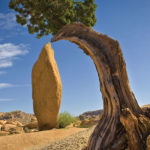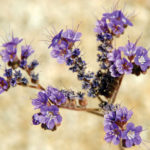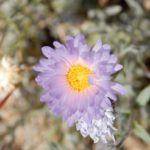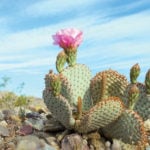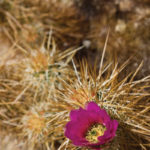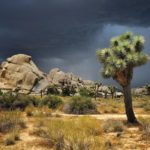Glorious Desert
The best deserts, I think, horrify at first glimpse. Looking toward the horizon, nothing between you and it but sharp edges and heat waves, a person should feel a quick rush of fear. And that should be followed by pity for the pioneers who crossed this landscape without maps, having no idea how long they’d be pulling cactus spines out of their heels, their throats closed from thirst.
Yet a lifetime in the Southwest has taught me that the truth of the arid landscape is something much different. The best deserts hide their secrets under cactuses and boulders, and only offer them up to people who know the magic phrase: “Yeah. I have time to stay a while.”
Joshua Tree National Park—first set aside as a monument by Franklin D. Roosevelt in 1936, but not gaining national park status until 1994—encloses 794,000 acres of one of the very best deserts. Two of the best deserts, in fact, because in valleys between six ranges of mountains the park holds both the lowland Colorado Desert and the high desert of the Mojave, which is cooler (peak highs around 105 instead of 115) and a little wetter (up to eight inches of rain a year as opposed to five). The east side of the park slants down toward the Colorado River while the west side leans toward a coast that is only a few hours’ drive away.
And although the two deserts are geologically unalike—completely different in their plants and ecology—in either one, the first glance seems one of utter hostility: mountains shaped like jawbones of filed teeth, plants with needles that can penetrate leather boots, and animals with poison bites.
But the wise traveler stops to look closer. And then the landscape comes alive with more than 900 species of flowering plants: gold poppy, gray ambonia, desert trumpet, aster, the wooly daisy, and wide, blue Canterbury bells. “And we’re still finding more,” says Joe Zarki, the park’s chief of interpretation. Seventy-five species of butterfly flit their shadows over tarantulas, and species of shrimp swim upside down in small pools caught in the crooks of folded mountains. In the lower Colorado Desert, spiders spin morning webs between the barbs of cholla (called “jumping cactus” for good reason); in the Mojave, desert night lizards perfect the art of being invisible under the fallen bark of Joshua trees. Deserts are landscapes for the miniaturist.

Deep in the heart of the Mojave, I get out of my truck on the park’s Geology Tour Road, a dirt track that skirts the Hexie Mountains. The cooling engine is the only sound, until I start to hear the bumblebees gathering nectar from late blooms and the slow hiss of wind through the reaching branches of the Joshua trees themselves. The air smells like warm rocks. Maybe three hours east of Los Angeles, not another person in sight, I turn a full circle, arms outstretched to the sun.
Stepping around the long, silver spines of a devil’s cactus, I climb some rocks that look like petrified stale bread. Joshua Tree is a paradise for rock climbers who have set hundreds of routes on these odd, beige formations. I once came to watch my wife climb; she was 60 feet up a sheer cliff when a woman stopped and got out of her car to gawk. “Do you think she’s okay?” she asked. “Oh, if you could see her face,” I replied, “you’d see the dopiest smile right now.”
I’m not as ambitious as my wife. I only scramble up 20 feet or so. In a crevice of sand, lizard tracks scratch a pattern I can’t read. A patch of rock goldenbush seems to grow without roots, offering pinhead yellow flowers to the bees that wander by. A hummingbird, breast iridescent in the creosote air, buzzes me and moves on. When I look out at the view to the horizon, at the Joshua trees in full bloom, at the red-tipped ocotillo, the world suddenly becomes too big in a glance. Turkey vultures casting shadows over quartz veins laced through the giant boulders seem to have no trouble taking it all in, though.
The first time my wife and I came to this park a dozen or so years ago we didn’t know what a Joshua tree looked like. We thought we were just looking at big yuccas until we thought to check the cover of U2’s album The Joshua Tree. (“We still get a lot of people coming because of that,” says a park official.) And in a way, that’s what the park’s signature plant is—a big yucca. Named by early pioneers who saw the tree’s branches as the arms of Joshua pointing the way—thirst and hope are powerful persuaders—the Joshua tree is also an ecosystem all its own. Yucca brevifolia shelters orioles and owls; kestrels rest in the branches from hunting trips; and Loggerhead Shrikes stab lizards on the spines, letting the meat ripen. On spring nights, Yucca moths pollinate the trees’ flowers, which look like popcorn bouquets.
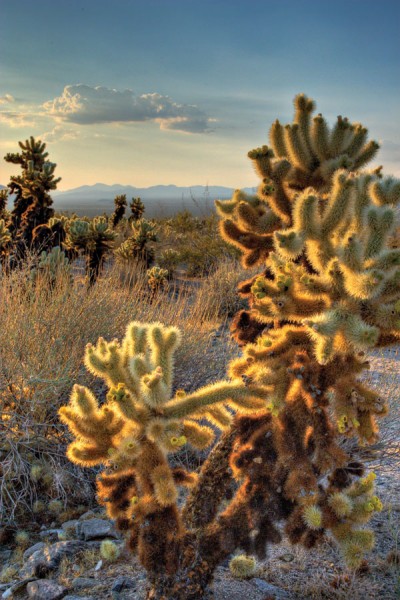
The animals knew from the beginning what it took people a while to learn. “Anybody who lived out here had to meet the landscape on its own terms,” says Zarki. “You have to reckon with the fact that the desert only offers so much.”
And for those who learned the lesson, the desert could be a surprisingly gentle place. In a tiny bowl canyon in the northwest edge of the park, the Keys family ranched, farmed, and mined the area for more than 50 years. Digging 25 feet or more to hit water, using equipment abandoned by those who could not find a way to water the desert into Eden and so fled for cooler climes, the Keys raised their kids here, accepting any guest who walked by. The family patriarch, Bill, even appeared in a couple Disney movies. The ranch, now open for tours, shows the way to survive in the desert—waste nothing and pay attention to the details.
On a small basis, the park simply absorbs human impact; when the people leave, the mines cave in and dirt blows over their trails. But now, with more than a half-million visitors a year, that impact lingers. Air quality is an increasing issue as the cities and agriculture draw closer. Coyotes prowl campgrounds, and increased trash has created a boom in the raven population, which has, in turn, brought a crisis to the tortoise population (because ravens enjoy nothing more than some tortoise for dessert).
But I tend to think this is all temporary. Time works differently in the desert, and with all the time in the world I watch a trail of ants working a low hill and see the curved track a snake took towards shade. Early in the morning the white petals of a ghost flower glisten with dew, and at night the sky is deeper by hundreds of light years to what I’m used to seeing.
“When I first came, this all looked dead to me,” says Jenn Schramm, a ranger in the park. “And now I see all kinds of stuff.” The very best deserts, I think, teach you how to look. It just takes a little time.
